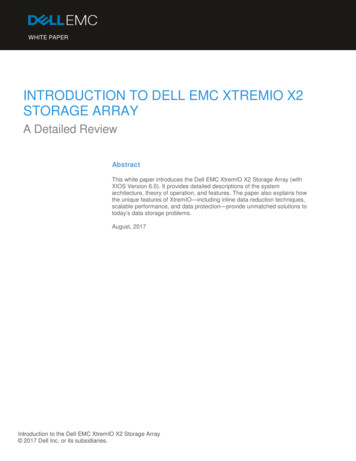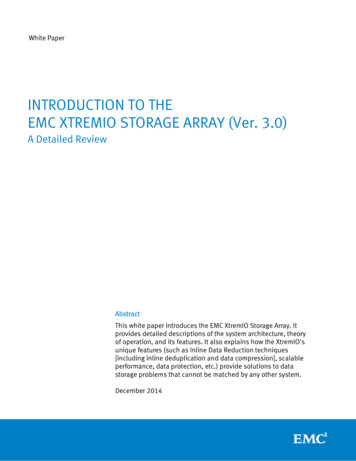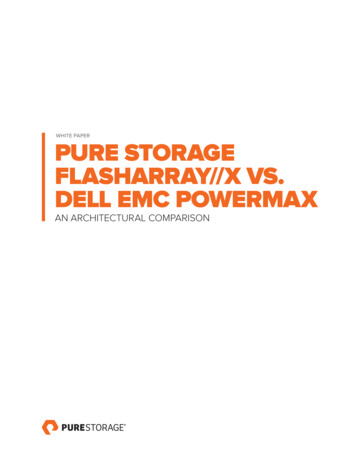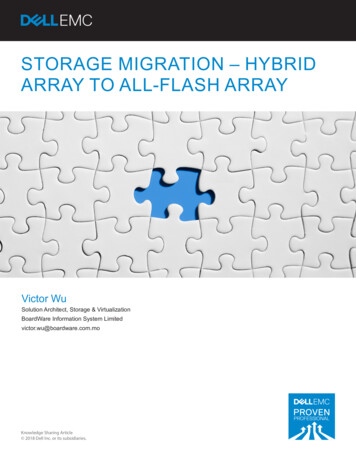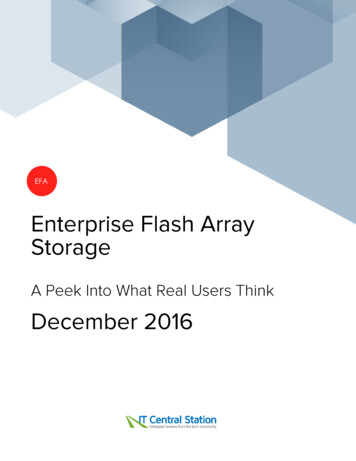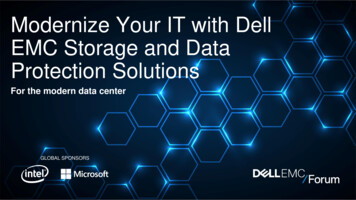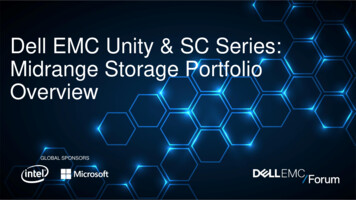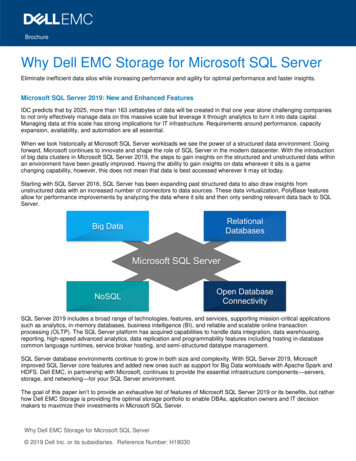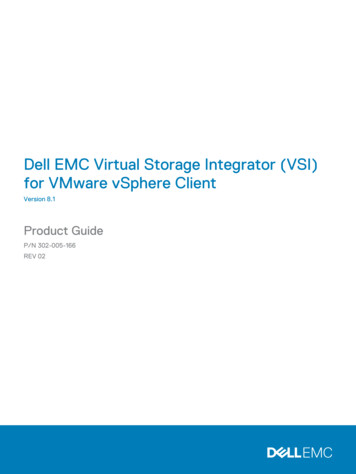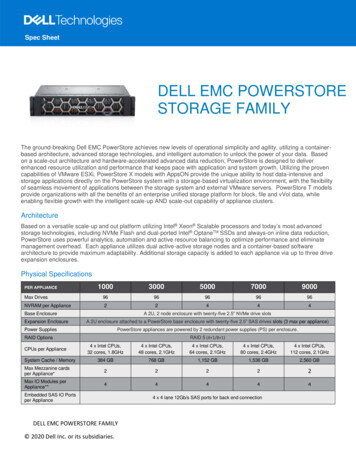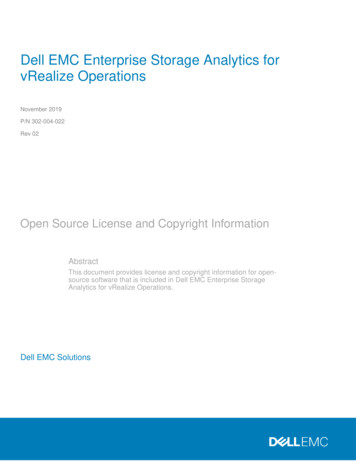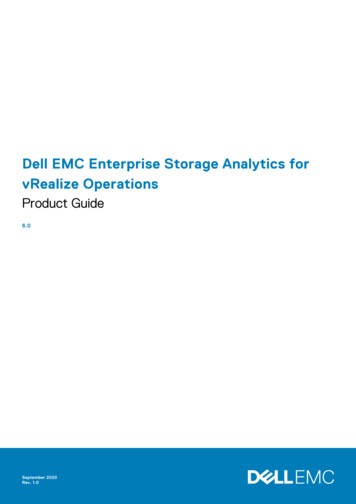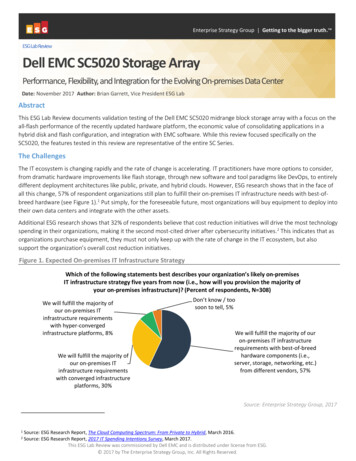
Transcription
Enterprise Strategy Group Getting to the bigger truth. ESG LabReviewDell EMC SC5020 Storage ArrayPerformance, Flexibility, and Integration for the Evolving On-premises Data CenterDate: November 2017 Author: Brian Garrett, Vice President ESG LabAbstractThis ESG Lab Review documents validation testing of the Dell EMC SC5020 midrange block storage array with a focus on theall-flash performance of the recently updated hardware platform, the economic value of consolidating applications in ahybrid disk and flash configuration, and integration with EMC software. While this review focused specifically on theSC5020, the features tested in this review are representative of the entire SC Series.The ChallengesThe IT ecosystem is changing rapidly and the rate of change is accelerating. IT practitioners have more options to consider,from dramatic hardware improvements like flash storage, through new software and tool paradigms like DevOps, to entirelydifferent deployment architectures like public, private, and hybrid clouds. However, ESG research shows that in the face ofall this change, 57% of respondent organizations still plan to fulfill their on-premises IT infrastructure needs with best-ofbreed hardware (see Figure 1).1 Put simply, for the foreseeable future, most organizations will buy equipment to deploy intotheir own data centers and integrate with the other assets.Additional ESG research shows that 32% of respondents believe that cost reduction initiatives will drive the most technologyspending in their organizations, making it the second most-cited driver after cybersecurity initiatives.2 This indicates that asorganizations purchase equipment, they must not only keep up with the rate of change in the IT ecosystem, but alsosupport the organization’s overall cost reduction initiatives.Figure 1. Expected On-premises IT Infrastructure StrategyWhich of the following statements best describes your organization’s likely on-premisesIT infrastructure strategy five years from now (i.e., how will you provision the majority ofyour on-premises infrastructure)? (Percent of respondents, N 308)We will fulfill the majority ofour on-premises ITinfrastructure requirementswith hyper-convergedinfrastructure platforms, 8%We will fulfill the majority ofour on-premises ITinfrastructure requirementswith converged infrastructureplatforms, 30%Don’t know / toosoon to tell, 5%We will fulfill the majority of ouron-premises IT infrastructurerequirements with best-of-breedhardware components (i.e.,server, storage, networking, etc.)from different vendors, 57%Source: Enterprise Strategy Group, 201712Source: ESG Research Report, The Cloud Computing Spectrum: From Private to Hybrid, March 2016.Source: ESG Research Report, 2017 IT Spending Intentions Survey, March 2017.This ESG Lab Review was commissioned by Dell EMC and is distributed under license from ESG. 2017 by The Enterprise Strategy Group, Inc. All Rights Reserved.
Lab Review: Dell EMC SC5020 Storage Array2The Solution: Dell EMC SC5020The Dell EMC SC5020 is a midrange direct- or SAN-attached block storage array with the performance, front- and back-endflexibility, and software functionality that delivers enterprise-class storage services to resource-strapped organizations withmidrange budgets. The Dell SC5020 is the first SC Series product that was released after Dell Computer and EMC Corp.merged in 2016. New enhancements include faster processors, more memory, and a simpler software model thateliminates cost and complexity with features enabled for the full array capacity.The SC5020 hardware is a complete refresh from the SC4020, and now includes an eight-core Intel E5-2630v3 andquadruple the system memory. The back-end connectivity is twice as fast (12Gb SAS). New 12Gb SAS expansion chassis areavailable: 2U x 12 3.5” drives (targeted for high-performance HDDs), 2U x 24 2.5” drives (targeted for SSDs), and 4U x 603.5” drives (targeted for high-capacity HDDs).Figure 2. Dell EMC SC5020Source: Enterprise Strategy Group, 2017The primary benefits of the SC5020’s new hardware are improved performance and increased capacity. Dell EMC cites 3Xthroughput compared with the SC4020 and a 45% increase in IOPS. Total system drive count for the SC5020 is 222, up from192, and the array’s raw capacity has doubled to 2 PB. Additional spec improvements include twice the number of replays(a.k.a., snapshots) and nearly twice the number of replicated source and target volumes.The base unit is a 3U chassis with 30 2.5” drive slots. The drives may be high-performance SAS HDDs, high-capacity nearlineSAS HDDs, SSDs, and/or self-encrypting drives (SEDs) for data-at-rest security. The SC5020 features an onboard 10GbEthernet mezzanine card, which can be configured with SFP or RJ45 connections. Each controller has a single PCIeexpansion slot that can support host connections for 12Gb SAS, 16Gb or 32Gb FibreChannel, or additional iSCSI ports. TheSC5020 can support a wide range of protocol connectivity including single (FC, SAS, and iSCSI) and dual (SAS iSCSI orFC iSCSI) with additional choices for interface speed, e.g., 16Gb/32Gb FC, and connection type, e.g., SFP /BaseT.The SC5020 continues the SC Series’ full-featured software offering including remote replication, Intelligent Deduplicationand Compression on both SSDs and HDDs (even in hybrid configurations), and Data Progression auto-tiering. Live Migrateenables multi-array federations with seamless data mobility and load balancing between arrays, and Live Volume providesauto-failover capability for an affordably priced business continuity solution.The SC5020 also introduces a much simpler software licensing model with no capacity tiers. All licenses are unlimited, up tothe maximum number of drives supported on the array. Optional software is now packaged as feature bundles to simplifyordering and reduce costs. The SC5020 and the SC Series includes integration with management, mobility, and dataprotection tools familiar to EMC users including PowerPath, ViPR, VPLEX, RecoverPoint for Virtual Machines, Connectrix,and Data Domain. 2017 by The Enterprise Strategy Group, Inc. All Rights Reserved.
Lab Review: Dell EMC SC5020 Storage Array3Post-validation Feature UpdatesSince ESG completed the validation, Dell EMC has added a new SC Series all-flash line. This line brings all the same SC Seriesfunctionality, with the added benefit of all-inclusive software licensing. In addition, Dell EMC has created a Future-ProofStorage Loyalty Program; a three-year satisfaction guarantee; 4:1 storage efficiency guarantee; and hardware investmentprotection. Customers are covered by this program when they purchase a new SC Series all-flash array with a maintenancecontract.ESG Lab TestedThe ESG Lab Validation began with an audit of the performance capabilities of the recently announced SC5020 hardwareplatform.PerformanceThe primary driver of the improved performance of the SC5020, over the previous generation SC4020, is its enhancedhardware. In each storage controller, the CPU is now an Intel E5 2630 v3 processor with eight cores versus a four-core E31265L v2 processor in the SC4020. Controller memory was increased 4X to 64 GB per controller and updated to DDR4technology. Back-end bandwidth to the drives was doubled with the use of 12Gb SAS for drive shelf connectivity. Front-endconnectivity and bandwidth were also improved with up to a total of eight ports of 32Gb/s FibreChannel for the SC5020versus four ports of 16Gb/s FibreChannel for the SC4020.ESG Lab tested the performance of an all-flash configuration of the SC5020 to characterize upper performance limits and todetermine performance in a typical application scenario. The test harness3 raised the I/O load to increase the number ofoutstanding I/Os at the array, known as queue depth. Array performance increased as more I/O was presented to the array.Small block performance is indicative of a read in an operational database, like doing a query to set up a transaction. Forsmall block reads, the SC5020 peaked at 383,511 IOPS and achieved about 365,000 IOPS at 1ms latency (see Figure 3).Figure 3. SC5020 Performance: IOPSSC5020 Performance: I/Os per SecondSequential Reads, 8KB Block Size, All-flash Config65300,00043200,0002100,000012481632Queue DepthIOPSLatency64128I/O response time (ms)I/O per second (IOPS)400,0000Source: Enterprise Strategy Group, 2017The test harness consisted of a single Dell R730 server, each with two ports of 16Gbs FibreChannel connections. The servers ran the WindowsServer 2016 operating system and the HammerDB workload generator to generate loads.3 2017 by The Enterprise Strategy Group, Inc. All Rights Reserved.
Lab Review: Dell EMC SC5020 Storage Array4Table 1. SC5020 Performance: 380.711.372.705.34Large block sequential reads are typical of operations like bulk reading data structures to prepare a backup, or doing a fulltable scan of an online database to populate a data warehouse. In ESG Lab’s testing, the SC5020 delivered up to 19,265MB/s throughput (see Figure 4).Figure 4. SC5020 Performance: ThroughputThroughput (MB/sec)SC5020 Performance: 06,0004,0002,0000Sequential Reads, 256KB Block Size, All-flash Config248163264128Queue DepthSource: Enterprise Strategy Group, 2017Finally, ESG compared the performance of the SC5020 with the previous generation SC4020. We compared the two arrayswith an IOPS-intensive workload, a 70/30 read/write OLTP workload, and a throughput-intensive workload. To get arepresentative point of comparison across the workloads, we chose a middle-of-the-range queue depth of eight. As shownin Figure 5, the SC5020 outperformed its predecessor up to 219%. 2017 by The Enterprise Strategy Group, Inc. All Rights Reserved.
Lab Review: Dell EMC SC5020 Storage Array5Figure 5. SC5020 Delivers Up to 219% Performance ImprovementSC5020 Delivers Up to 219% Performance ImprovementSC5020 vs. SC4020 Relative Performance, Block Size as Noted, Queue Depth 8, All-flash ConfigIOPS (8KB) 18%OLTP (8KB) 74%Throughput (256KB) 219%0%50%100%150%200%250%300%350%Relative PerformanceSC4020SC5020Source: Enterprise Strategy Group, 2017What the Numbers MeanIn the all-flash configuration tested, SC5020 performance compares favorably to a state-of-the-market standalone all-flasharray. A maximum of 385,311 IOPS, 365,000 IOPS at one millisecond latency, and latencies below 250 microseconds forIOPS below 100,000 are comparable with market-leading all-flash arrays. Throughput of up to 19,265 MB/s exceeds most oftoday’s all-flash arrays due to the SC5020 architecture with FC SAN support.A comparison with the previous generation SC4020 shows the benefit of improved hardware, especially the increasedbandwidth of the front-end FC and back-end SAS connections. The performance improvements vary depending on theapplication workload and I/O patterns. For example, ESG measured a 74% improvement for an OLTP workload due primarilyto CPU and memory improvements, and a 219% improvement due primarily to bandwidth improvements.Why This MattersStorage performance correlates directly to organizational performance—increases in revenue, productivity, and oftencustomer and user satisfaction ride on the back of increased performance of the IT infrastructure, including storage.The SC5020 delivers enterprise-class performance at midrange storage prices. During ESG Lab testing, SC5020performance topped out at 385,311 IOPS and 19,265MB/s throughput. For workloads below 100,000 IOPS, the SC5020maintained fast all-flash I/O response times of less than 250 microseconds.Data ProgressionData Progression, the SC Series’ auto-tiering method, is key to many inherent advantages of the platform. Data Progressionbegan as a way to store frequently accessed data on high-performance disk drives, or the outer tracks of high-performancedisk drives, and less important data to higher capacity disk drives that are more affordable. The technology has now evolvedto become a way to optimize performance, capacity, and cost across multiple types and configurations of HDDs and SSDs ina single storage array.The SC Series’ “0-100% flash” architecture lets customers target specific price/performance ratios for their initialconfiguration, deploying as much or as little flash as needed as performance and capacity needs change. 2017 by The Enterprise Strategy Group, Inc. All Rights Reserved.
Lab Review: Dell EMC SC5020 Storage Array6Within a single SC Series array, different media types can be deployed in different data protection configurations, forexample, write-intensive SSDs in RAID 10 for the maximum performance of hot data, read-intensive SSDs in RAID 5 to lowercost while maintaining read performance, and HDDs of varying speeds—7.2K RPM, 10K RPM, and 15K RPM—in RAID 6 forlowest cost to hold cold data. The SC Series can support up to three different storage tiers. By default, all writes go to thehighest performing drives and then Data Progression moves the data to more space-efficient tiers for subsequent reads.Data Progression enables an SC array to maintain performance while decreasing an application’s /GB over time.ESG Lab tested the Dell EMC SC5020’s Data Progression capability with a SQL Server database as show in Figure 6. The arraywas configured with a hybrid mix of six SSDs and 12 10K RPM HDDs. Tier 1 was five SSDs containing RAID 10 and RAID 5, andTier 3 was 11 HDDs in RAID 6. A Dell EMC PowerEdge R830 server hosted a SQL Server database and a HammerDB OLTPdatabase workload generator that simulates order and payment processing, and stock checking, at a wholesale supplier.SQL Server ran on Windows Server on bare metal and was configured for “maximum server memory” of 100 GB. Thedatabase contained 750 GB of data. Approximately 20% of database capacity was actively being referenced and updated;the remainder was ina
The Solution: Dell EMC SC5020 . The Dell EMC SC5020 is a midrange direct-or SAN-attached block storage array with the performance, front- and back-end flexibility, and software functionality that delivers enterprise-class storage services to resource -strapped organizations with midrange budgets. T he Dell SC5020 is the first SC S eries product .
